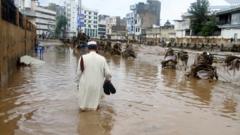Australia is renowned for its stunning natural landmarks, with the Great Barrier Reef being a celebrated UNESCO World Heritage Site, attracting divers from around the globe to its vibrant, biodiverse waters. However, on the opposite side of the country lies another marvel, Ningaloo Reef, the world's largest fringing reef, stretching hundreds of kilometers along Australia's north-western coast. This picturesque area is known for its lush oceanic forests and rich marine life, including manta rays and whale sharks, awaiting explorers beneath its turquoise surface.
Sadly, this biodiversity hotspot is currently facing a crisis. A marine heatwave has struck Ningaloo, causing stress to the coral systems and triggering extensive bleaching—a critical phenomenon where corals turn white and risk dying. This event is especially concerning as it marks the first instance of simultaneous bleaching affecting both Australia’s eastern and western reefs. “It's like a relentless underwater bushfire,” warns Paul Gamblin, leader of the Australian Marine Conservation Society, emphasizing the escalating threat posed by these unprecedented conditions.
Originating from the Caribbean earlier this year, the marine heatwave has devastated coral habitats across the Indo-Pacific. While Ningaloo avoided bleaching during the Great Barrier Reef's distress last year, this summer has seen the region's temperatures surge alarmingly high, resulting in a severe coral decline. Experts refer to this as part of the ongoing global bleaching event affecting over 80% of the world’s coral reefs. Dr. Kate Quigley, a marine research scientist, elucidates the damaging relationship between corals and their symbiotic algae, which provide color and essential biological functions. Prolonged warmth disrupts this balance, causing corals to become ill and, if conditions persist, leading to substantial coral mortality.
Despite ongoing monitoring of Ningaloo's ecosystem, researchers acknowledge gaps in their understanding. Dr. Tom Holmes, a marine science leader, explains the necessity of prolonged follow-up surveys to clarify the coral mortality rates. Tourist experiences are rapidly changing too; visitors like Jenna-Rae Clark note the stark difference in the underwater landscape, describing it as "like snorkelling on a corpse,” raising fears of a decline in tourism to the region. Local residents echo this concern, feeling disheartened by the changes and the potential loss of tourism-driven livelihoods.
The scientists surveying Ningaloo universally cite the overarching culprit for the marine heatwave: climate change driven by rising carbon emissions. With ocean temperatures reaching alarming levels due to global warming, authorities continue to face criticism for allowing fossil fuel projects, like the North West Shelf gas plant, to remain operational. As the industry fuels the economy, conservationists worry that governmental decisions are compromising the health of treasured marine environments.
In response to the crisis, scientists strive to identify resilient coral species through selective breeding and mapping efforts. Initiatives underway seek to improve the resilience of coral populations against elevated temperatures. However, experts stress the urgent need to address the root causes of climate change, as merely patching problems won’t be enough for long-term survival.
Gamblin accentuates this duality, urging for immediate action to protect coral reefs that sustain around 25% of marine life and confer vital ecosystem services, such as coastal protection and support for local economies. As the struggle against climate change continues, the health of oceans hangs in the balance, with experts insisting that failure to act may yield catastrophic impacts for marine biodiversity globally.



















